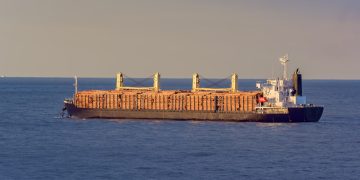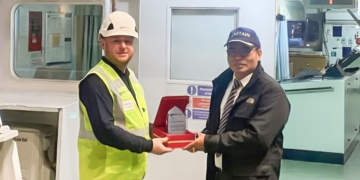In its latest Safety Digest, the UK MAIB presented a submarine’s hit into a prawn trawler’s gear, which put the fishermen’s life at great risk. UK MAIB emphasized that the responsibility for collision avoidance between a dived submarine and any other vessel rests entirely with the submarine’s command team. In this case, the crew misinterpreted the noise of the fishing vessels as a noise coming from a merchant ship.
The incident
It was a clear, calm day and a prawn trawler was towing its nets in coastal fishing grounds; the depth of water was about 100m and there were over 60 fishing boats, mainly trawlers, operating in the area. At the same time, a nuclear-powered submarine was conducting a submerged passage through the area. The submarine was deep below the surface where periscopes and radar could not be used; this meant that it was reliant on its sonar systems to detect noises from other vessels in order to avoid them.
As the submarine approached the fishing grounds, the command team onboard realised that there was a fishing fleet ahead, but pressed on with the deep passage. While navigating around the fishing fleet, the submarine snagged the prawn trawler’s gear.
Onboard the trawler, the skipper and his crewmen realised things were going wrong when the tow warps came bar-taut and the boat was pulled astern. The crew managed to quickly release the winch brakes, freeing the trawl warps, and the starboard warp ran out free of the boat. However, the port warp became fouled in the winch drum, dragging the trawler’s stern underwater before the supporting gallows collapsed, and the warp parted under the weight of the submarine’s pull.
The trawler’s gear was lost, but it was able to return safely to harbour under its own power; no submarine was seen at the surface and communications were never established. Onboard the submarine, some unusual noises had been heard, but a collision with a fishing boat or its gear was not considered and the submarine continued its passage.
Lessons learned
- Responsibility for collision avoidance between a dived submarine and any other vessel rests entirely with the submarine’s command team. Even though submarines are well equipped with modern sonar systems, things can still go wrong, especially in an area with a high concentration of fishing vessels. This accident happened because the command team in the submarine mistook the noise made by the prawn trawler to be that of a merchant ship. The submarine was at a depth where no risk of collision existed with merchant ships, so no avoiding action was taken by the submarine and the collision resulted.
- The crew of the fishing vessel suffered a harrowing experience and their lives were in peril until the port warp broke. It was extremely fortunate that the crew were on deck and able to release the winch brakes immediately. Had they been resting below when the accident happened, the outcome could have been catastrophic. Although unlikely, think through how to deal with this eventuality – prepare and be ready for any emergency.
- Although there was nothing more the trawler’s crew could have done, lessons can still be learnt:
- AIS information is widely used by submarines and their shore headquarters to understand fishing vessel operating patterns so, if fitted with AIS, all fishing boats should transmit continuously for the benefit of other vessels, including submarines.
- The quickest way to raise the alarm when things go wrong is to press the DSC alert button on a VHF radio. This alerts the coastguard and, critically, includes the vessel’s position. DSC was not used by the trawler’s skipper and, had the port warp not parted, the boat would have submerged rapidly, potentially without time to raise the alarm. Using DSC in an emergency needs to become instinctive.
- When fishing boats are operating in submarine exercise areas, they should always keep a listening watch on VHF radio, a good lookout, transmit AIS and listen to the SUBFACTs broadcast.

































































